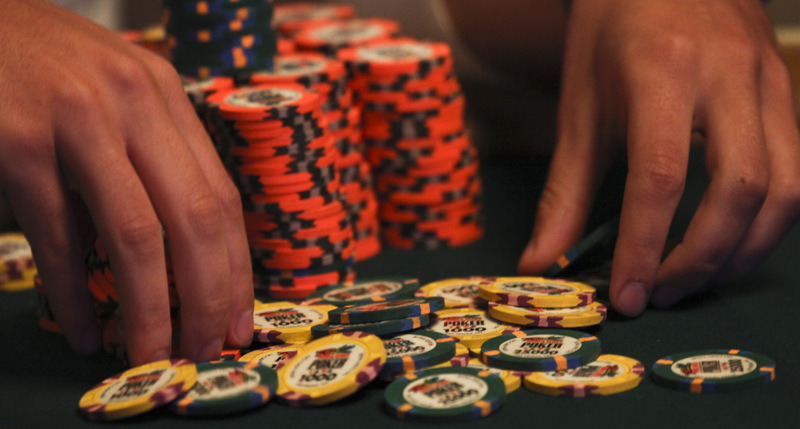






Poker Strategy: Five Common Mistakes To Avoid With Suited ConnectorsSign Up For The Upswing Poker Lab Today To Increase Skill And Earnings |
|
|

By Dan Baker
It can be tough to know when, and how, to play a suited connector in hold’em. If you neglect to consider important factors, such as stack sizes, and your opponent’s tendencies, you will likely make a costly mistake with these hands.
You’re about to read five tips that will help you understand the mistakes you need to avoid making with suited connectors, and how to maximize your winnings with them.
No. 1 — Avoid three-betting against stacks of 60 big blinds or shallower
When the preflop raiser has fewer than 60 big blinds in their stack, you should be less inclined to three-bet suited connectors, particularly low ones like 6-5 suited or 7-6 suited.
When you’re deep stacked, suited connectors work great as three-bet bluffs because of their great playability. Against short stacks, however, the stack-to-pot ratio gives you less room to maneuver post-flop and decreases your implied odds. This change makes them less effective and rarely profitable three-bet bluffs.
No. 2 — Avoid three-betting against calling stations
You can probably imagine why three-bet bluffing with a suited connector is less effective against a player who doesn’t like to fold. When there’s little chance your opponent will fold, you lose a major incentive to three-bet the hand. But there’s also a much less obvious reason why three-betting suited connectors is a perilous mistake vs calling stations.
These loosey goosey players will call three-bets with way more hands that dominate you — hands other players would fold. We’re talking hands like A-6 suited, K-7 suited, and J-8 suited, which dominate your 6-5 suited and 8-7 suited. This will result in the occasional nasty cooler when you both hit trips or a flush.
No. 3 — Rarely four-bet suited connectors
When thinking about which hands make the best four-bet bluffs, there are three things you need to consider:
Of these three, by the most important is your hand’s blocker effects. This is because the ranges involved in four-bet situations are very tight and being able to rule out a few strong hands from your opponent’s range makes a significant difference.
Suited connectors actually possess negative blocking effects. They block hands from your opponents’ three-bet/folding range, such as A-5 suited or A-6 suited, and don’t block any strong hands that will continue. These hands do have both solid playability and decent implied odds, but even these are stunted with the low stack-to-pot ratios in four-bet pots.
No. 4 — Avoid overcalling (except from the big blind)
It might be tempting to overcall with suited connectors, but unless you’re in the big blind, it is a losing play that should be avoided. I am going to show you why.
Let’s take, for example, a six-max game in which every player is 100-big blinds effective. Suppose middle position opens to 2.5 big blinds, cutoff flats, and it’s up to us on the button with 6 5
5 .
.
Now, we are in-position with a very playable hand, which means we will likely over-realize our hand’s equity, but we also have to account for the threat of a squeeze behind. One of the two players behind will three-bet approximately 10 percent of the time, in which case we will be forced to fold and forfeit our equity. The players behind will also call a high percentage of the time, which lowers our hand’s equity.
These are impossible things to calculate precisely, but it’s safe to say that these two sets of factors are at least close to cancelling each other out. This leaves us with a shortage of around three to five percent equity.
With all that said, over-calling can be reasonable as an exploitative adjustment if there is a weak player in the hand and you know the players behind are unlikely to squeeze.
No. 5 — Don’t call three-bets against short-stacks
Suited connectors can profitably call three-bets with deep stacks pretty often, but they lose a lot of their value when the effective stack size drops to around 50 blinds.
This happens because their once-great implied odds are diminished. Consequently, you need to pay much more to see a flop compared to the potential win. Consider the difference:
One final nail in the coffin for suited connectors at this stack depth is the reduced fold equity post-flop, which is a result of more hands becoming committed to the pot.
Conclusion
At the end of the day, playing suited connectors is not so difficult when you understand which scenarios to avoid and why. Often times, the difficult part is having the discipline to get out of the way — suited connectors look too pretty to fold.
Avoiding the five plays I’ve shared with you today is a good place to start. Just because suited connectors look great doesn’t mean they’ll always play great!

Sign up for the Upswing Poker Lab today for step-by-step instructions and examples to master both the fundamental theories and situational exploits to greatly increase your skill and earnings.
